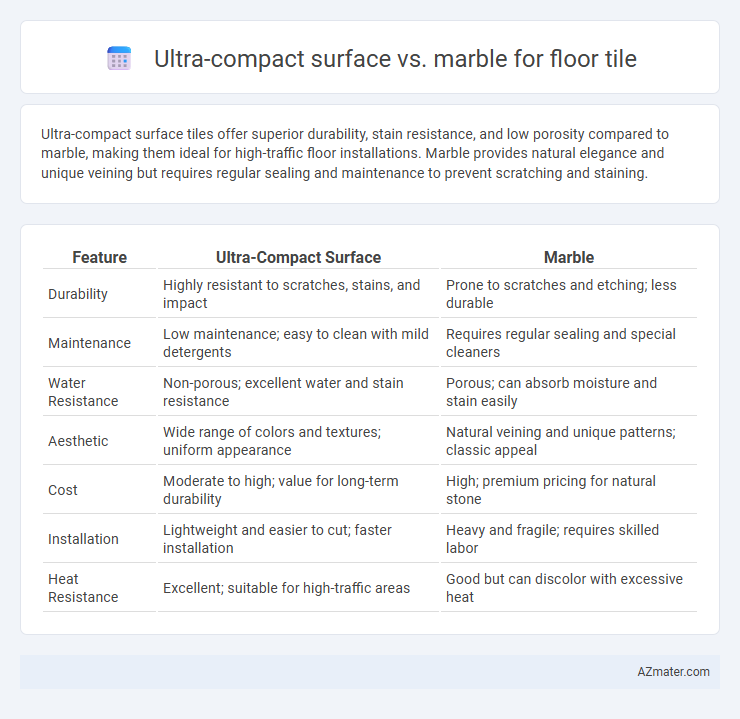Ultra-compact surface tiles offer superior durability, stain resistance, and low porosity compared to marble, making them ideal for high-traffic floor installations. Marble provides natural elegance and unique veining but requires regular sealing and maintenance to prevent scratching and staining.
Table of Comparison
| Feature | Ultra-Compact Surface | Marble |
|---|---|---|
| Durability | Highly resistant to scratches, stains, and impact | Prone to scratches and etching; less durable |
| Maintenance | Low maintenance; easy to clean with mild detergents | Requires regular sealing and special cleaners |
| Water Resistance | Non-porous; excellent water and stain resistance | Porous; can absorb moisture and stain easily |
| Aesthetic | Wide range of colors and textures; uniform appearance | Natural veining and unique patterns; classic appeal |
| Cost | Moderate to high; value for long-term durability | High; premium pricing for natural stone |
| Installation | Lightweight and easier to cut; faster installation | Heavy and fragile; requires skilled labor |
| Heat Resistance | Excellent; suitable for high-traffic areas | Good but can discolor with excessive heat |
Introduction to Ultra-Compact Surfaces and Marble
Ultra-compact surfaces, composed of highly compressed natural minerals and advanced resins, offer superior durability, resistance to scratches, stains, and UV rays, making them ideal for high-traffic flooring applications. Marble, a natural stone formed from metamorphosed limestone, is prized for its unique veining and luxurious appearance but requires more maintenance due to its porous nature and susceptibility to etching and staining. Choosing between ultra-compact surfaces and marble for floor tiles depends on balancing aesthetic preferences with long-term performance and maintenance requirements.
Key Material Properties: Ultra-Compact Surfaces vs Marble
Ultra-compact surfaces offer superior hardness and scratch resistance compared to marble, making them highly durable for high-traffic areas. Marble, composed primarily of calcite, is more porous and susceptible to staining and etching, requiring regular sealing for maintenance. Ultra-compact materials also exhibit lower water absorption rates and enhanced UV resistance, ensuring long-lasting aesthetic appeal and structural integrity.
Durability and Longevity Comparison
Ultra-compact surfaces exhibit superior durability compared to marble, offering high resistance to scratches, stains, and impact due to their dense composition and advanced manufacturing processes. Marble, while aesthetically timeless, is prone to etching, chipping, and requires regular sealing to maintain its appearance and longevity in high-traffic areas. Over time, ultra-compact tiles demonstrate enhanced longevity with minimal maintenance, making them a practical choice for long-lasting flooring solutions.
Aesthetic Appeal and Design Versatility
Ultra-compact surfaces offer a sleek, uniform aesthetic with a wide variety of color options and textures that mimic natural materials, providing high design versatility for modern, minimalist interiors. Marble tiles boast timeless elegance and unique veining patterns that enhance luxury and classic appeal but have less design flexibility due to limited color choices and natural inconsistencies. Both materials create visually stunning floors, but ultra-compact surfaces deliver greater adaptability for innovative design combinations and contemporary styles.
Maintenance Requirements and Care
Ultra-compact surfaces offer superior resistance to stains, scratches, and moisture, making maintenance straightforward with just regular cleaning using mild detergents and non-abrasive cloths. Marble requires more intensive care due to its porous nature, demanding regular sealing and prompt attention to spills to prevent staining and etching. Choosing ultra-compact materials significantly reduces long-term upkeep efforts compared to the high-maintenance requirements intrinsic to marble flooring.
Resistance to Stains, Scratches, and Heat
Ultra-compact surfaces offer superior resistance to stains, scratches, and heat compared to marble, making them ideal for high-traffic and demanding environments. Engineered with advanced manufacturing processes, ultra-compact tiles resist chemical etching and abrasion, maintaining their appearance over time. Marble, while elegant, is porous and softer, prone to staining from acidic spills, scratching from heavy use, and damage under high temperatures, requiring more maintenance and careful handling.
Installation Process and Considerations
Ultra-compact surfaces offer a streamlined installation process due to their lightweight nature and uniform thickness, allowing for easier handling and quicker fitting compared to marble. Marble requires careful measurement and precise cutting to accommodate its natural variances and heavier weight, often necessitating specialized tools and experienced professionals. Considering the subfloor quality is crucial for both materials, but ultra-compact surfaces can tolerate slight imperfections better, reducing preparation time and costs.
Cost Analysis: Ultra-Compact Surfaces vs Marble
Ultra-compact surfaces typically cost between $50 to $100 per square foot, offering a budget-friendly alternative to marble, which ranges from $75 to $250 per square foot depending on quality and origin. Installation expenses for ultra-compact tiles are generally lower due to their durability and ease of handling, while marble demands skilled labor and maintenance, increasing overall costs. Long-term cost efficiency favors ultra-compact surfaces as they resist stains and scratches better, reducing replacement and upkeep expenses compared to marble flooring.
Environmental Impact and Sustainability
Ultra-compact surfaces boast low porosity and durability, reducing the need for frequent replacement and minimizing waste compared to marble floor tiles. Marble extraction involves extensive quarrying, leading to significant habitat disruption and carbon emissions, whereas ultra-compact surfaces often utilize recycled materials and more sustainable production processes. Choosing ultra-compact for flooring supports reduced environmental footprint and aligns with sustainable building practices due to its longevity and lower resource consumption.
Best Applications and Use Cases for Floor Tiles
Ultra-compact surfaces excel in high-traffic commercial areas, kitchens, and bathrooms due to their exceptional durability, resistance to scratches, stains, and heat, making them ideal for both flooring and countertops. Marble offers a luxurious, timeless aesthetic suitable for low-traffic residential spaces, such as living rooms and bedrooms, where its natural veining adds elegance but requires careful maintenance due to susceptibility to scratching and staining. For floor tiles, ultra-compact surfaces provide superior performance in demanding environments, while marble is best reserved for decorative, low-impact applications where visual appeal is prioritized.

Infographic: Ultra-compact surface vs Marble for Floor Tile
 azmater.com
azmater.com